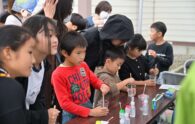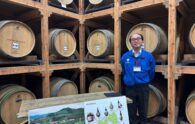What do you think of when you hear the word “oni” (Japanese demon)?
In each region of Japan, there are various legends and cultures surrounding oni. These oni often appear in folk tales and cultural events, and are depicted as having different appearances and personalities in each iteration.
Kitakami City in Iwate Prefecture has attracted widespread attention in recent years, with some postulating that it might be the setting of a popular game and manga series. Additionally, the city also has numerous traditions and folk arts related to oni.
In Kitakami City, there is a museum called House of Oni, where you can learn and investigate all sorts of facts about oni. This time, we’ll be talking about the museum’s exhibits and events..jpg) Picture 1 (Front Entrance)
Picture 1 (Front Entrance)
At the House of Oni, there are various items and materials about oni, which create an atmosphere where you can feel their presence. Long beloved by the people of Kitakami and tourists from within and outside the prefecture, this institution celebrated its 30th anniversary in 2024.
In Japan, “oni” is often synonymous with “mysterious evil creature” and “terrifying creature,” but there are also depictions of oni as “guardian deities” who have protected villages and “strong beings.” In this way, they are described as entities who are anywhere from malevolent creatures to virtuous deities.
At this museum, oni are classified into 4 groups: “Ōhito,” “Yōkai,” “Kishin,” and “Gaki,” and are displayed accordingly. You can view documents, pictures, masks made to look like oni, and more. It is apparent that oni have been interpreted in different ways based on the time period and region, as they are diverse in appearance and nature depending on the region and legend, as seen in the museum.
As for other exhibits, you can enjoy the atmosphere of the various festivals involving oni all across Japan with real footage from the festivities.
In addition, Japan isn’t the only country with legends about oni. Although their appearances and names vary per country, there are also exhibits featuring the oni of Indonesia, India, China, and other countries at the museum.
.jpg)
Picture 2 (Exhibit Picture)
However, the most notable display in the museum is the Oni Sword Dance exhibit, which showcases Kitakami’s traditional folk entertainment that has been passed down through the generations. Here is a brief explanation about the Oni Sword Dance.
The Oni Sword Dance is one of the Nenbutsu Sword Dances (dances to honor the dead or exorcise evil spirits) passed down in the Kitakami area. Dancers wear a menacing oni mask and dance vigorously, which earned the Oni Sword Dance its name and continuing popularity. There is one theory that it began in the years 701-704 when people chanted while dancing to spread Nenbutsu (Buddhist prayer), and yet another theory that it began in the years 806-810 as a Nenbutsu dance meant to dispel evil spirits and lead the masses to the path of enlightenment. In September 2024, a local preservation group performed the Oni Sword Dance in New York, mesmerizing the many people in attendance.
The Oni Sword Dance involves about 8 dancers dancing vigorously to the beat of taiko drums and flute music. The dancers’ outfits have many unique features, including the mask. These outfits are on full display at the House of Oni, so feel free to take your time examining them.
.jpg) Picture 3 (Exhibit Picture)
Picture 3 (Exhibit Picture)
Furthermore, the Oni Sword Dance is performed regularly at the House of Oni, and in addition to being able to enjoy the show (shows are on hold until March), there is an event in February and March where you can try doing the Oni Sword Dance yourself!
This is the perfect opportunity to fully experience the Oni Sword Dance’s appeal and the culture behind it.
By all means, please come to Kitakami in Iwate Prefecture, a city filled to the brim with the wondrous charm of oni, and visit the House of Oni.
Japanese
「鬼の館」へみなさんは「鬼」と聞いてどんな印象をお持ちでしょうか。
日本各地には「鬼」にまつわる様々な言い伝えや文化が残されており、昔話や行事に「鬼」が度々登場し、その性格から姿かたちなど様々に表現されています。
岩手県北上市は、近年、人気のゲームや漫画の舞台となっているのではないかと推察がされるものがあり、広く注目を浴びているほか、「鬼」にまつわる文化や民族芸能が数多く残されております。
北上市には、「鬼の館」という博物館があり、「鬼」をめぐる様々な事柄を学び、調べることができます。今回はこちらの施設の展示物や行われているイベントについて御紹介します。
写真①(正面入り口)
「鬼の館」では、様々な「鬼」の資料があり、「鬼」の存在を間近に感じることが出来ます。この施設は、令和6年で開館30周年を迎え、多くの市民や、県内外の観光客から長く親しまれています。
「鬼」とは、日本では、「得体のしれない悪い物」「恐ろしい物」の代名詞として使われることが多いですが、村を守った「守り神」あるいは「強い物」として伝えられている「鬼」もあるなど、「悪」となる存在から「善」となる存在まで、様々に表現されています。
本施設では、「鬼」を「大人」「妖怪」「鬼神」「餓鬼」の4つに区分して、展示しています。「鬼」を模した面や、書き物、絵などを見ることができ、地域や言い伝えにより様々な見た目や性質の「鬼」がいることから、時代や地域によって鬼の捉え方が異なるものであったことがわかります。
その他の展示として、日本各地で「鬼」にまつわる特徴的な祭が開催されていることから、実際の祭りの映像を交えてその雰囲気を楽しむことができます。
また、「鬼」に関する言い伝えがあるのは、日本だけではありません。その姿や名称は各地域によって異なりますが、本施設では、インドネシアやインド、中国など、各国に伝わる「鬼」のような存在にまつわる展示も行っています。
写真②(展示写真)
本施設においてもっとも注目すべきものは、北上市に伝わる民俗芸能「鬼剣舞」にまつわる展示内容です。こちらの「鬼剣舞」についても、簡単に御紹介します。
「鬼剣舞」は北上市周辺に伝わる「念仏剣舞」の1つで、威嚇的な鬼の面をつけ、勇壮に踊るところから「鬼剣舞」と呼ばれ、親しまれています。701~704年に念仏を広めるために唱えながら踊ったのが始まりという説や、806~810年に悪霊退散・衆生済度の念仏踊りとして伝えられたのが始まりともいわれています。令和6年9月には、ニューヨークで市民団体による「鬼剣舞」が披露され、多くの方を魅了しました。
「鬼剣舞」は、太鼓や笛の演奏に合わせて8人程の踊り手が力強く舞い踊ります。踊り手の衣装には、「面」をはじめとした様々な特徴があります。これらの衣装は「鬼の館」でも展示されているので、ぜひじっくり見てみてください。
写真③(展示写真)
なお、「鬼の館」では、定期的に「鬼剣舞」が披露され、その公演を楽しむことができるほか(3月までの公演は終了しています)、2月と3月には「鬼剣舞」を体験できるイベントも開催されます!
「鬼剣舞」の魅力を深く感じることが出来る素敵な機会になることでしょう。
ぜひ、「鬼」の不思議な魅力がつまった岩手県北上市の「鬼の館」にいらしてください。
-1260x450.jpg)


